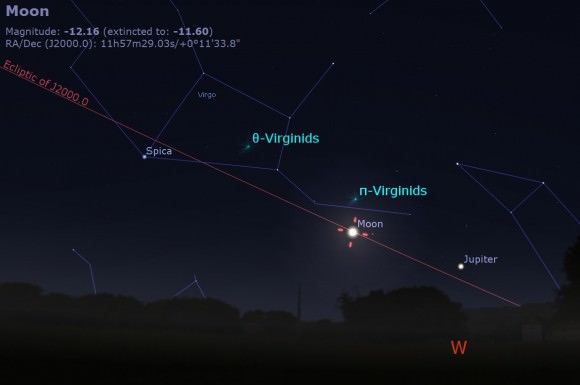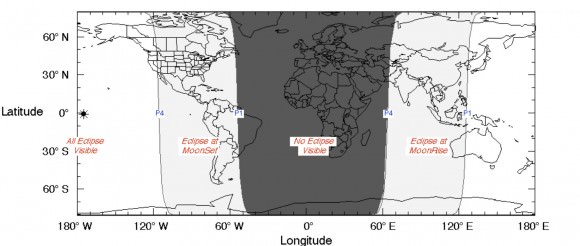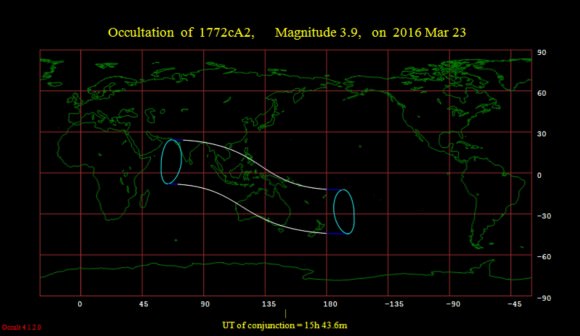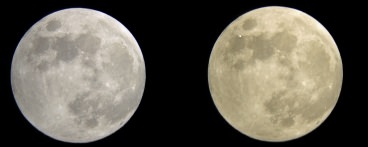Ready for Easter? The first of two lunar eclipses for 2016 occurs this week, though it’s an event so subtle, you might not notice it at first glance. We’re talking about Wednesday evening’s (morning for North America) penumbral lunar eclipse. If a total solar eclipse such as the one that crossed Indonesia and the Pacific Ocean earlier this month is the ultimate astronomical experience, then a penumbral lunar eclipse is at the other end of the spectrum, a ghostly shading on the Moon that is barely noticeable.

Circumstances: A penumbral eclipse occurs when the Moon just grazes the outer faint shadow of the Earth, missing its dark inner core known as the umbra, as occurs during a total lunar eclipse. Standing on the Earthward-facing side of the surface of the Moon this Wednesday, you’d see a partial solar eclipse looking back at the Earth.

The penumbral eclipse begins at 9:39 Universal Time (UT) on Wednesday, March 23rd, reaches its peak at 11:48 UT with the Moon 78% immersed in the Earth’s penumbral shadow, and ends on 13:55 UT. The eclipse occurs during moonrise for Far East Asia Wednesday night, and moonset for the Americas on the morning of Wednesday, March 23rd. The central Pacific will witness the entire eclipse crossing the International Dateline, with the Moon high overhead for observers in Hawaii.

Tales of Saros
This particular eclipse is part of saros 142, and is number 18 of 74 in the series, which began on September 19th, 1709. Stick around until July 22nd 2214, and you can witness the very first total lunar eclipse of saros 142, which runs out to November 4th, 2989. If you saw the penumbral lunar eclipse of March 13th, 1998 which was visible from most of North America, then you caught the last lunar eclipse of the series.
As does every lunar eclipse by necessity, this week’s event falls on the Full Moon. The March Full Moon is known as a Worm Moon, and in 2016 is also the Paschal or first Full Moon after the vernal equinox setting us up for Easter this weekend. On the Gregorian calendar, the rule for Easter is the ‘first Sunday after the first Full Moon after the fixed date of March 21st for the vernal equinox,’ though an equinox won’t fall on March 21st again until 2102 AD. This is because of another rule from the Gregorian calendar, the skipping of century leap years except on years (such as 2000) divisible by 400, resets the date… all in a never-ending effort to keep sidereal and mean solar time in sync.
By coincidence, the Moon also occults (passes in front of) the +3.9 magnitude star Eta Virginis during the eclipse for observers in southeast Asia. Thanks to Malaysian-based observer Sharin Ahmad (@shahgazer on Twitter) for pointing this out to us.

So, what is there to see during a penumbral eclipse? Well, you might just notice a slight tea-colored shading on the lower southern limb of the Moon right around greatest eclipse. Make the judgment call: would you notice a penumbral eclipse at all if you didn’t know one was underway? The higher in the sky the Moon is, the better, as a low elevation Moon tends to become tinted via atmospheric refraction.
Here’s a photographic challenge: keeping all of your camera settings the same, image the Moon before during and after the eclipse… can you see the difference? A penumbral eclipse would be worthy of a short animation as well.

When is the next total lunar eclipse? Well, we’ve got another penumbral on September 16th of his year, but the next total lunar doesn’t occur until January 31st, 2018, again favoring the Pacific and western North America.
Oh well. We can always reminiscence of the lunar eclipse tetrad of past years. Let us know if you catch sight of this week’s penumbral eclipse.
…and while you’re out under (hopefully) clear March skies don’t miss Jupiter at its prime… and just maybe, binocular Comet 252P LINEAR, making its appearance for northern hemisphere observers this weekend as it flies through the constellation Scorpius in the pre-dawn.
-Be sure to send those pictures in to Universe Today!

